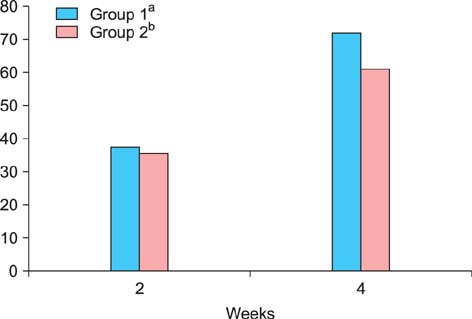Korean J Urol.
2014 Jan;55(1):36-40. 10.4111/kju.2014.55.1.36.
The Effect of Terpene Combination on Ureter Calculus Expulsion After Extracorporeal Shock Wave Lithotripsy
- Affiliations
-
- 1Department of Urology, Hanyang University College of Medicine, Seoul, Korea. syparkuro@hanyang.ac.kr
- KMID: 1988450
- DOI: http://doi.org/10.4111/kju.2014.55.1.36
Abstract
- PURPOSE
Terpene combination (Rowatinex) is known to help with the expulsion of urinary stones. The aim of this study was to determine how Rowatinex affects the expulsion of remnant stones after shock wave lithotripsy (SWL).
MATERIALS AND METHODS
Clinical data were collected retrospectively from 499 patients with a diagnosis of ureteral stones who underwent SWL from January 2009 to August 2012. Ureteral stones were diagnosed in all patients by kidney, ureter, and bladder x-ray and abdominal computed tomography (CT). The progress of patients was documented every 2 weeks to confirm remnant stones after SWL. The patients with remnant stones underwent SWL again. Group 1 consisted of patients who were prescribed an analgesic, Tamsulosin 0.2 mg, and Rowatinex. Group 2 consisted of patients who were prescribed only an analgesic and Tamsulosin 0.2 mg. The expulsion rate of urinary stones was compared between groups.
RESULTS
The expulsion rate of urinary stones was not significantly different between the two groups after 2 weeks. However, after 4 weeks, group 1 had a significantly higher expulsion rate (72.2% compared with 61.1%, p=0.022). Fifteen patients (10.2%) in group 1 and 40 (11.4%) in group 2 had to undergo ureteroscopic removal of the stone (p=0.756). Acute pyelonephritis occurred in one patient (0.7%) in group 1 and in one patient (0.3%) in group 2 (p=0.503).
CONCLUSIONS
The long-term administration of Rowatinex for 4 weeks increased the expulsion rate of urinary stones after SWL.
Keyword
MeSH Terms
Figure
Reference
-
1. Yilmaz E, Batislam E, Basar MM, Tuglu D, Ferhat M, Basar H. The comparison and efficacy of 3 different alpha1-adrenergic blockers for distal ureteral stones. J Urol. 2005; 173:2010–2012.2. Chung HS, Kim HK, Park CM. The varying success of ureteroscopic removal of stone (URS) in relation to the different locations and sizes of upper ureter stones. Korean J Urol. 2005; 46:920–924.3. Chaussy C, Schmiedt E, Jocham D, Brendel W, Forssmann B, Walther V. First clinical experience with extracorporeally induced destruction of kidney stones by shock waves. 1981. J Urol. 2002; 167:1957–1960.4. Bak CW, Yoon SJ, Chung H. Effects of an alpha-blocker and terpene mixture for pain control and spontaneous expulsion of ureter stone. Korean J Urol. 2007; 48:517–521.5. Kang DI, Cho WY, Kim TH, Chung JM, Park J, Yoon JH, et al. Effect of Tamsulosin 0.2 mg on the short-term treatment of urinary stones: multicenter, prospective, randomized study. Korean J Urol. 2009; 50:586–590.6. Preminger GM, Tiselius HG, Assimos DG, Alken P, Buck C, Gallucci M, et al. 2007 Guideline for the management of ureteral calculi. J Urol. 2007; 178:2418–2434.7. Djaladat H, Mahouri K, Khalifeh Shooshtary F, Ahmadieh A. Effect of Rowatinex on calculus clearance after extracorporeal shock wave lithotripsy. Urol J. 2009; 6:9–13.8. Tan YH, Wong M. How significant are clinically insignificant residual fragments following lithotripsy? Curr Opin Urol. 2005; 15:127–131.9. Fine JK, Pak CY, Preminger GM. Effect of medical management and residual fragments on recurrent stone formation following shock wave lithotripsy. J Urol. 1995; 153:27–32.10. Romics I, Siller G, Kohnen R, Mavrogenis S, Varga J, Holman E. A special terpene combination (Rowatinex®) improves stone clearance after extracorporeal shockwave lithotripsy in urolithiasis patients: results of a placebo-controlled randomised controlled trial. Urol Int. 2011; 86:102–109.11. Engelstein D, Kahan E, Servadio C. Rowatinex for the treatment of ureterolithiasis. J Urol (Paris). 1992; 98:98–100.12. Mukamel E, Engelstein D, Simon D, Servadio C. The value of Rowatinex in the treatment of ureterolithiasis. J Urol (Paris). 1987; 93:31–33.13. Al-Mosawi AJ. Essential oil terpenes: adjunctive role in the management of childhood urolithiasis. J Med Food. 2010; 13:247–250.14. Geinitz W. Animal experiments on urinary calculus prevention. Munch Med Wochenschr. 1956; 98:895–897.15. Caramia G, Di Gregorio L, Tarantino ML, Galuffo A, Iacolino R, Caramia M. Uric acid, phosphate and oxalate stones: treatment and prophylaxis. Urol Int. 2004; 72:24–28.16. Cipriani P, Mancini C. Microbiological activity of a terpene product used in the treatment of urinary diseases. Gazz Int Med Chir. 1972; 77.17. Santos FA, Silva RM, Campos AR, De Araujo RP, Lima Junior RC, Rao VS. 1,8-cineole (eucalyptol), a monoterpene oxide attenuates the colonic damage in rats on acute TNBS-colitis. Food Chem Toxicol. 2004; 42:579–584.18. Santos FA, Rao VS. Antiinflammatory and antinociceptive effects of 1,8-cineole a terpenoid oxide present in many plant essential oils. Phytother Res. 2000; 14:240–244.19. Horvath N. The use and effect of the terpene combination in nephrolithiasis. Arztl Prax. 1963; 15:917–918.
- Full Text Links
- Actions
-
Cited
- CITED
-
- Close
- Share
- Similar articles
-
- Clinical Experience of Extracorporeal Shock Wave Lithotripsy for Urinary Calculi
- The Effect of Tamsulosin on Expulsion of Ureteral Stones after Extracorporeal Shock Wave Lithotripsy
- The Effect of Tamsulosin and Nifedipine on Expulsion of Ureteral Stones after Extracorporeal Shock Wave Lithotripsy
- Effects of Extracorporeal Shock Wave Lithortripsy Experimentally Induced Cholelithiasis and Organs in the Dog
- Additive Expulsion Effect of Tamsulosin after Shock Wave Lithotripsy for Upper Ureteral Stones


